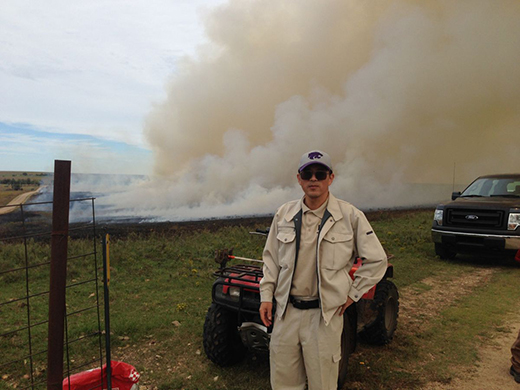K-State researchers work to enhance prescribed burning safety with NSF grant
Tuesday, Nov. 28, 2023

K-State researchers are working to enhance prescribed burning safety as part of a team that has received a $2 million grant from the National Science Foundation. Zifei Liu, assistant professor of biological and agricultural engineering, is pictured above at a prescribed burn event. | Download this photo.
MANHATTAN — Kansas State University researchers are part of a team that has been awarded a $2 million grant from the National Science Foundation to develop technology to enhance the safety of prescribed burning.
Prescribed burning is when vegetation is intentionally set on fire as a technique for managing land and natural resources, and it offers a variety of benefits. Controlled fires replenish soil nutrients, increase forage production for livestock and decrease invasive overgrowth. They also reduce the risk and impact of uncontrolled wildfires by removing built-up vegetation.
However, prescribed fires also carry safety and environmental concerns. An escaped or reignited fire can cause damage and injuries, and smoke causes air pollution in nearby and downwind communities.
The project, "Smart and Safe Prescribed Burning for Rangeland and Wildland Urban Interface Communities," connects innovative research in social sciences and engineering to develop technology to support safer burning practices. The project uses data collected through satellite imagery, uncrewed aircraft systems and crowdsensing through landowner partners who conduct prescribed burns to develop the technologies.
The K-State researchers involved in the multidisciplinary project are Audrey Joslin, associate professor of geography and geospatial sciences in the College of Arts and Sciences; Zifei Liu, assistant professor of biological and agricultural engineering in the Carl R. Ice College of Engineering; and Walter Fick, professor of agronomy and extension rangeland management specialist in the College of Agriculture.
The researchers are collaborating with landowners and members of the Eastern Kansas and Gyp Hills Prescribed Burn Associations in the areas of Medicine Lodge and Paola. They are also doing outreach to schools in those communities.
Joslin is studying how technology shapes and supports local fire-related land management practices. She is especially interested in how technology plays into landowners' perceptions of their land and the risks of prescribed burning.
"I hope my research will aid the user-friendliness of the technology we develop so that it meets the needs of communities engaging in prescribed burning," Joslin said.
Liu is leading the creation of an environmental risk index, a tool that will incorporate quantitative measurements of weather and fuel conditions to help land managers easily identify the best days for burning with minimal smoke and maximum safety.
Fick is leading the work with schools to teach students about prescribed burning technology and career opportunities in science, technology, engineering and math.
Other institutions involved in the project are Georgia State University, the University of Kansas and the University of Missouri. They are working on fire behavior modeling, grassland fuel mapping and hot-spot detection.
"Our long-term goal is to make prescribed burning safer so that land managers in Kansas and beyond will feel capable and comfortable enough to make more use of that beneficial strategy," Joslin said.
